Epidermal growth factor-like domain 7 is a marker of the endothelial lineage and active angiogenesis
- PMID: 24740971
- PMCID: PMC4107133
- DOI: 10.1002/dvg.22781
Epidermal growth factor-like domain 7 is a marker of the endothelial lineage and active angiogenesis
Abstract
Epidermal growth factor-like domain 7 (Egfl7) expression in the developing embryo is largely restricted to sites of mesodermal progenitors of angioblasts/hemangioblasts and the vascular endothelium. We hypothesize that Egfl7 marks the endothelial lineage during embryonic development, and can be used to define the emergence of endothelial progenitor cells, as well as to visualize newly-forming vasculature in the embryo and during the processes of physiologic and pathologic angiogenesis in the adult. We have generated a transgenic mouse strain that expresses enhanced green fluorescent protein (eGFP) under the control of a minimal Egfl7 regulatory sequence (Egfl7:eGFP). Expression of the transgene recapitulated that of endogenous Egfl7 at sites of vasculogenesis and angiogenesis in the allantois, yolk sac, and in the embryo proper. The transgene was not expressed in the quiescent endothelium of most adult organs. However, the uterus and ovary, which undergo vascular growth and remodeling throughout the estrus cycle, expressed high levels of Egfl7:eGFP. Importantly, expression of the Egfl7:eGFP transgene was induced in adult neovasculature. We also found that increased Egfl7 expression contributed to pathologic revascularization in the mouse retina. To our knowledge, this is the first mouse model that enables monitoring of endothelial cells at sites of active vasculogenesis and angiogenesis. This model also facilitated the isolation and characterization of EGFL7(+) endothelial cell populations by fluorescence activated cell sorting (FACS). Together, our results demonstrate that the Egfl7:eGFP reporter mouse is a valuable tool that can be used to elucidate the mechanisms by which blood vessels form during development and under pathologic circumstances.
Keywords: eGFP; endothelial reporter; transgenic mice; vascular development.
© 2014 Wiley Periodicals, Inc.
Conflict of interest statement
The authors declare no competing financial interests.
Figures
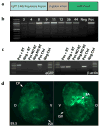
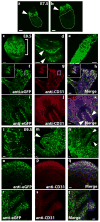
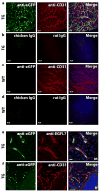
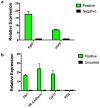

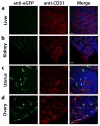
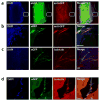


Similar articles
-
Egfl7, a novel epidermal growth factor-domain gene expressed in endothelial cells.Dev Dyn. 2004 Jun;230(2):316-24. doi: 10.1002/dvdy.20063. Dev Dyn. 2004. PMID: 15162510 Free PMC article.
-
EGFL7 is a chemoattractant for endothelial cells and is up-regulated in angiogenesis and arterial injury.Am J Pathol. 2005 Jul;167(1):275-84. doi: 10.1016/S0002-9440(10)62972-0. Am J Pathol. 2005. PMID: 15972971 Free PMC article.
-
Novel expression of EGFL7 in placental trophoblast and endothelial cells and its implication in preeclampsia.Mech Dev. 2014 Aug;133:163-76. doi: 10.1016/j.mod.2014.04.001. Epub 2014 Apr 19. Mech Dev. 2014. PMID: 24751645 Free PMC article.
-
EGFL7: Master regulator of cancer pathogenesis, angiogenesis and an emerging mediator of bone homeostasis.J Cell Physiol. 2018 Nov;233(11):8526-8537. doi: 10.1002/jcp.26792. Epub 2018 Jun 19. J Cell Physiol. 2018. PMID: 29923200 Review.
-
EGFL7: a unique angiogenic signaling factor in vascular development and disease.Blood. 2012 Feb 9;119(6):1345-52. doi: 10.1182/blood-2011-10-322446. Epub 2011 Dec 7. Blood. 2012. PMID: 22160377 Free PMC article. Review.
Cited by
-
Epidermal growth factor-like domain 7 promotes migration and invasion of human trophoblast cells through activation of MAPK, PI3K and NOTCH signaling pathways.Mol Hum Reprod. 2015 May;21(5):435-51. doi: 10.1093/molehr/gav006. Epub 2015 Feb 9. Mol Hum Reprod. 2015. PMID: 25667199 Free PMC article.
-
EGFL7 enhances surface expression of integrin α5β1 to promote angiogenesis in malignant brain tumors.EMBO Mol Med. 2018 Sep;10(9):e8420. doi: 10.15252/emmm.201708420. EMBO Mol Med. 2018. PMID: 30065025 Free PMC article.
-
Altered feto-placental vascularization, feto-placental malperfusion and fetal growth restriction in mice with Egfl7 loss of function.Development. 2017 Jul 1;144(13):2469-2479. doi: 10.1242/dev.147025. Epub 2017 May 19. Development. 2017. PMID: 28526753 Free PMC article.
-
miR-126 regulates glycogen trophoblast proliferation and DNA methylation in the murine placenta.Dev Biol. 2019 May 1;449(1):21-34. doi: 10.1016/j.ydbio.2019.01.019. Epub 2019 Feb 14. Dev Biol. 2019. PMID: 30771304 Free PMC article.
-
Modulating endothelial cells with EGFL7 to diminish aGVHD after allogeneic bone marrow transplantation in mice.Blood Adv. 2022 Apr 12;6(7):2403-2408. doi: 10.1182/bloodadvances.2021005498. Blood Adv. 2022. PMID: 34654057 Free PMC article.
References
-
- Baker M, Robinson SD, Lechertier T, Barber PR, Tavora B, D’Amico G, Jones DT, Vojnovic B, Hodivala-Dilke K. Use of the mouse aortic ring assay to study angiogenesis. Nat Protoc. 2012;7:89–104. - PubMed
-
- Carmeliet P. Mechanisms of angiogenesis and arteriogenesis. Nat Med. 2000;6:389–395. - PubMed
-
- Carmeliet P. Angiogenesis in health and disease. Nat Med. 2003;9:653–660. - PubMed
Publication types
MeSH terms
Substances
Grants and funding
LinkOut - more resources
Full Text Sources
Other Literature Sources
Molecular Biology Databases
Research Materials

